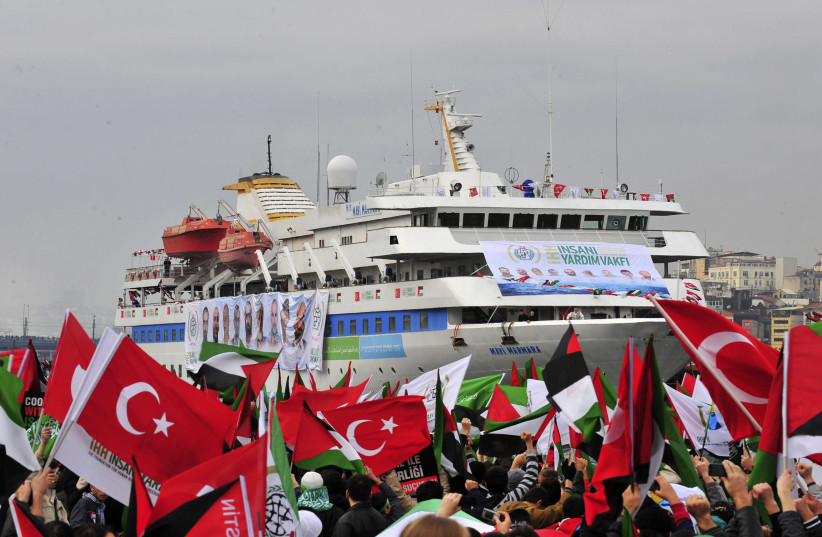It is unclear how great a threat the next Turkey maritime flotilla will be if it challenges Israel’s blockade of Gaza next month, the Meir Amit Intelligence and Terrorism Information Center said in a report on Wednesday.
The first reports about the potential flotilla came out on November 20, with bombastic predictions of reaching 1,000 small vessels to challenge the Israeli navy by activist Volkan Okclugu.
Since then, the flotilla leaders have made some progress in moving forward, but the report said that their goals and organization seem very different from the infamous May 2010 Mavi Marmara flotilla that led to violent altercations on the high seas and years of geopolitical repercussions.
A report by the Meir Amit Center, which is filled with former top Israeli intelligence officials and maintains ongoing contact with currently serving intelligence officials, stated, “It seems that the flotillas are still only in the planning stages and are more in the spirit of exhibiting an act of solidarity with the Gaza Strip, and it is not clear when they intend to set sail and whether they really intend to reach the shores of Gaza.”
For one, the flotilla leaders say they do not actually expect to fully break Israel’s blockade of Gaza as much as to disrupt the ongoing shipping of military supplies to Israel and to heavily distract the Israeli navy, as noted by the intelligence center.
In essence, the idea appears to increase the cost and aggravation to Israel of maintaining the blockade.
What are the flotilla's plans?
If the flotilla does take off, the report said, its plans are to first sail to Cyprus, where it will pick up humanitarian goods for Gazans. Next, it would try to sail through international waters to Gaza but would be ready to be stopped, inspected, and towed by the Israeli navy to the port at Ashdod.
This would require heavy IDF naval resources and time and could also create significant maritime traffic to slow down critical military supplies that Israel needs for the war effort, according to the report.
Once docked at Ashdod, the flotilla leaders would still expect their humanitarian supplies to arrive in Gaza via land.
There are still questions about whether the flotilla will happen or whether it will be smaller than envisioned. This is both because the organizers have only mentioned December as a general target period but gave no actual date to cast off and because they are still discussing raising funds to purchase ships, said the Meir Amit Center.
In fact, originally, some organizers said the flotilla would be cast off on November 23. The ongoing temporary ceasefire has probably also complicated the flotilla’s efforts, though they could still sail, noting that the IDF has said it will retain security control of aspects of Gaza even after the war ends.
IDF sources recently said they were doubtful that the flotilla would actually make it anywhere near Gaza, and certainly not in numbers similar to the 2010 Mavi Marmara incident.
Some past attempts at flotillas failed when a mix of international diplomatic pressure, legal pressure from insurance companies, and potential lawsuits for taking part in dangerous maritime activities made it financially difficult to buy and field a sufficient number of ships.
Insuring and investing in such a flotilla has significant downsides when the expectation is that the ship will be seized by the IDF for an indefinite period in potential violation of the blockade.
Flotilla organizers challenge the blockade as illegal and, more specifically, claim that the IDF cannot stop them if they permit an inspection and are only bringing humanitarian goods.
However, they are aware that the IDF is likely to seize their vessels anyway based on the claim that blockades do not need to distinguish between the type of goods being transported, especially if the goods are allowed to reach Gaza afterward by land.
Strangely, the report flagged that the largest number of ships that may participate in the flotilla of a projected 4,500 people include 133 from Russia and 104 from Spain, with only 12 so far from Turkey itself.
Also, the report mentions other threatened, smaller flotillas that have been discussed by Hamas activists Zahar Birai and the Muslim Brotherhood of England.
Other activists involved with the flotilla efforts named in the report, among others, include Jordanian parliament member Fares al-Ajarama, professor Torstein Dahle, and Mavi Marmara Association chief Ismail Songur.
Intel: Unclear how big a threat next Turkey flotilla is
The first reports about the potential flotilla came out on November 20, with bombastic predictions of reaching 1,000 small vessels to challenge the Israeli navy by activist Volkan Okclugu.

